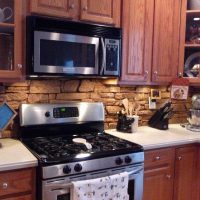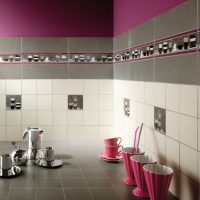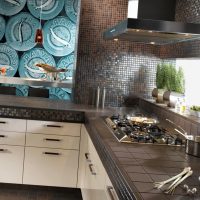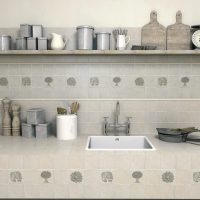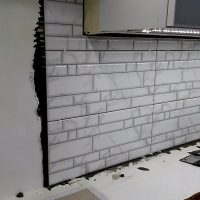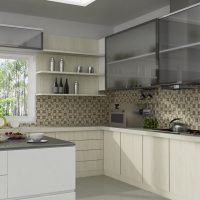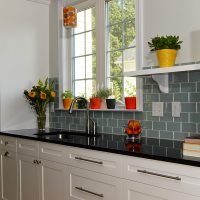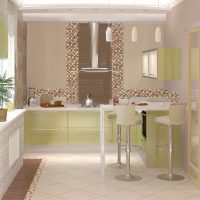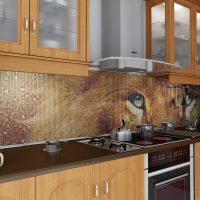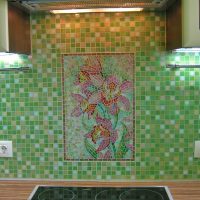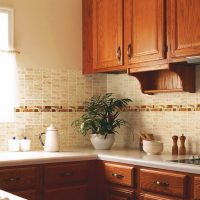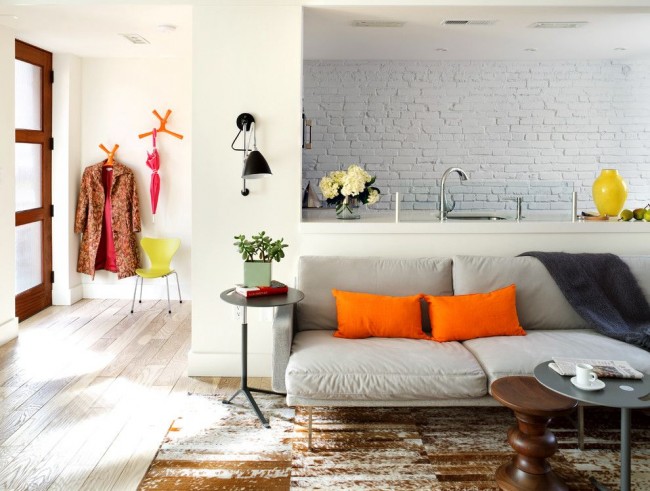Tile apron for the kitchen: design and new ideas in 2017
An apron is called not only part of the cookery clothes, but also part of the wall, in the gap between the wall cabinets and the cutting tabletop. During the repair, it is important to choose the right lining, which will be practical and aesthetic. The thoughtful design of the kitchen apron will emphasize the stylistic decision of the interior and decorate the functional room.

Kitchen design with apron

Kitchen apron
Content
What is important to know about facing kitchen surfaces?
The surface near the stove, cutting countertops and sinks gets dirty most. This is the wall span within 50-60 cm, where fat settles when frying, drops when washing dishes and food juices when cutting meat, vegetables and fruits. With frequent cooking, the surface of the kitchen apron in 2-3 days becomes dirtier than the floors. But cooking should take place in a clean environment, so hygiene is first and foremost in the kitchen.
The original design of the apron in the kitchen made of ceramic tiles and other materials consisting of small fragments is fraught with the complexity of laying and slicing. Very rarely, the gap from the countertop to the wall cabinets coincides with the format of the facing materials in several rows or with a continuous canvas. Sometimes it’s easier to outweigh the hinged unit of the kitchen unit by changing the size of the apron than to engage in laborious cutting of tiles.
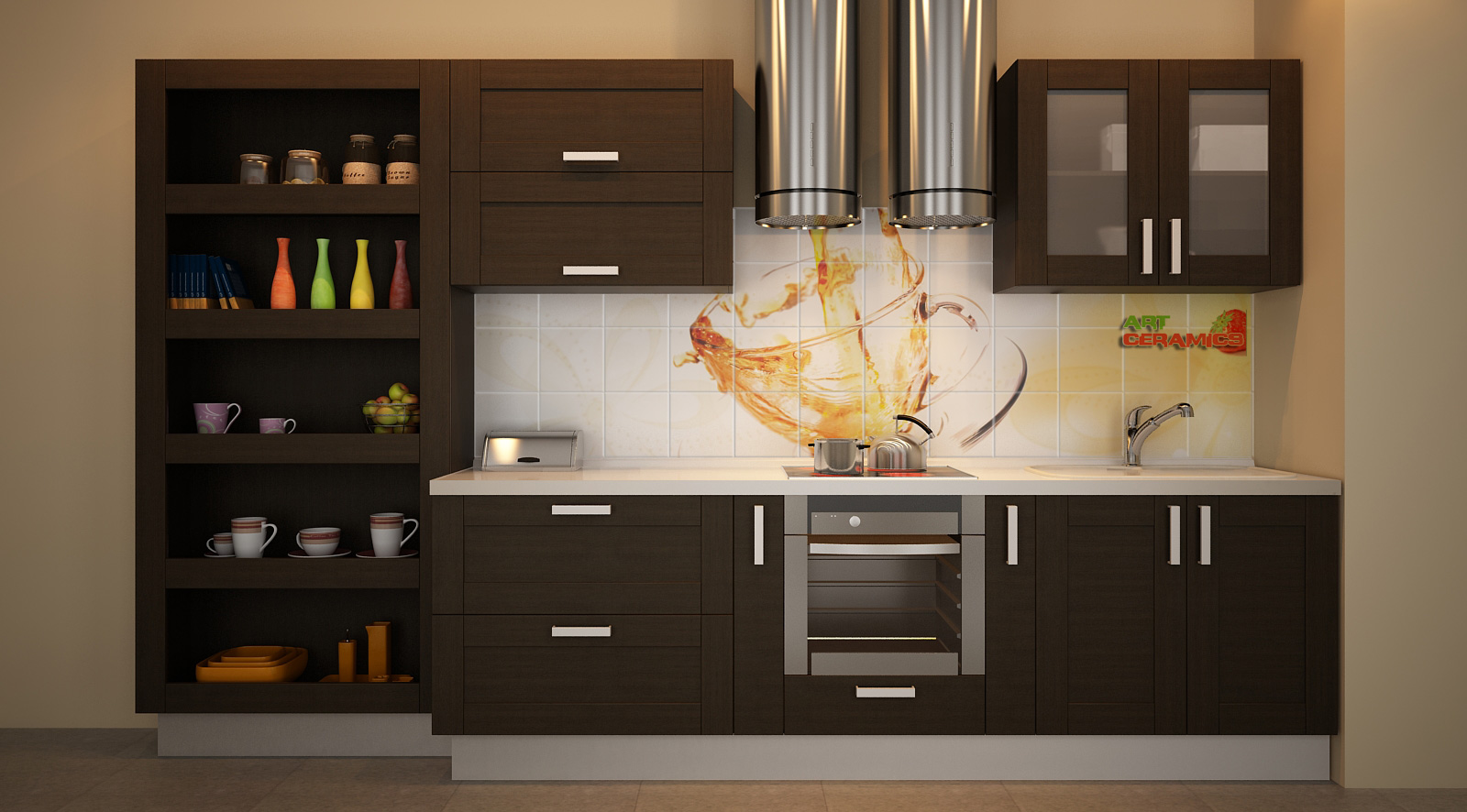
Apron with a pattern in the interior of the kitchen
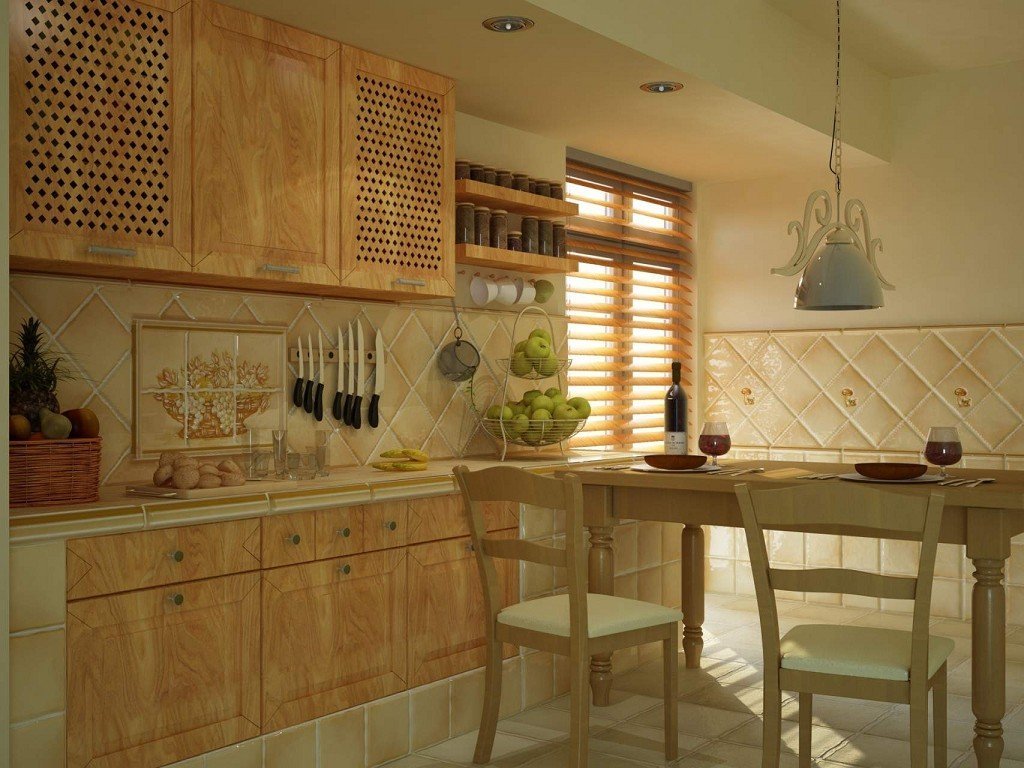
Beautiful kitchen design with apron

Kitchen design with apron
Attention! For cutting tiles or ceramic finishes, a standard tile cutter is enough. But he will not take porcelain stoneware and some varieties of natural stone prepared for facing. Some construction supermarkets offer services for cutting solid materials with a waterjet machine.
Tile installation methods and decor
Regardless of the area of the kitchen apron, ceramic tiles or tiles can be laid in different ways.
- Standard - rectangles or squares join the seam into the seam, grouting the cement or adhesive base as much as possible. The easiest way that even beginners can easily cope with, but it is important to make the same seams. Minimal tile consumption is needed, and there is an opportunity to save on the rest of the lot, which is often offered at a discount. Knowing the area of the apron, it is easy to choose the lining of the right size and calculate the number of tiles individually.
- Diagonally - a popular method of laying tiles. It visually expands the space of a small kitchen, especially if the whole room is faced with this method, and not just an apron. But you have to make a purchase with a margin - when cutting, there is a high probability of the formation of an uneven edge, chips and other defects. Usually this is entrusted to specialists with a tool, and the wall “in a rhombus” can be finished independently. Often this layout is combined with other varieties in the design of the kitchen apron made of tiles.
- "In a run" or with a displacement of the seam, a common type of tiling. Reminds a bricklaying if these are small rectangles. Tile materials imitating brick and formatted stone are laid only this way. It always looks good, sometimes rows with offset are used for diagonal and vertical styling. The disadvantage is that a lot of time is spent on cutting.
- Seamless laying requires tile materials with perfect cutting. In fact, there are seams, but they are almost invisible, especially on a matte texture. It does not involve grouting, but for the purpose of hygiene, the apron is replaced with a transparent sealant or building silicone. It is used under Italian tile and porcelain tile without bevels or finely cut facing marble.
- In the "herringbone" - another kind of lining with rectangular fragments. The old method, borrowed from the diagonal laying of parquet at a right angle, as in the photo.
- "Chess" is the most famous way of combining tiles of contrasting colors. It is borrowed from the decoration of black and white marble floors, which were practiced in Gothic castles and temples. This installation is also suitable for the same type of tile with a simple pattern, when the turns form an intricate pattern.
- The end-to-end linear method is used for laying the sides, frames for decorative inserts, skirting boards and other elongated decor. For example, an apron for a kitchen made of tiles - a design with a finished panel.
- Kaleidoscopic cladding involves multi-colored decor, where you can combine direct masonry and mosaic fragments.
Note! The same tile will be perceived differently in the design of the apron for the kitchen, even if you do not apply color variations.
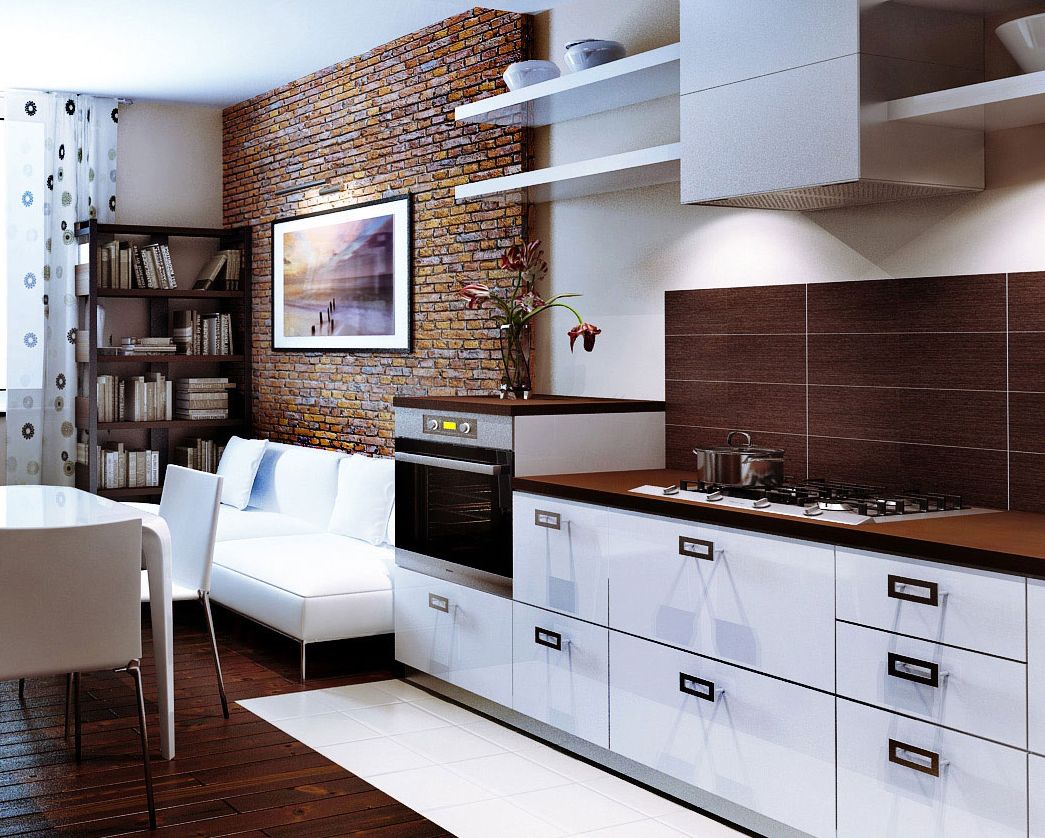
Brown apron in the interior of the kitchen

Kitchen design with apron

Beautiful apron in the interior of the kitchen
Tile sizes
|
Small format |
Up to 20 cm, minimum consumption, you can do without cutting |
|
Standard |
Rectangle or square from 20 cm to 40 cm |
|
Large format |
Sides from 40 to 60 cm and more |
Spectacular décor or mosaic tiles can decorate the cooking area. They can be combined with any method of laying the design of the apron in the kitchen. For this purpose, you can use:
- colored tiles on the background of a plain wall;
- inserts from different materials of the same format with the main lining (mirror and glass tiles, metal plates, stone, bamboo, cork, textured wood);
- tile of a different color;
- printed pattern on glass or tile (1 square tile, 4 or 9);
- voluminous bas-relief;
- functional inserts - tiles in the form of stands, hangers or hooks.
Tip. Do not be afraid to experiment by creating your own unique kitchen interior. You can choose colored and plain materials. And the contrasting color of the grout will emphasize the original cladding, as in the photo.

Apron with the image of fruits in the interior of the kitchen

Kitchen design with brown apron
Brief characteristics of apron tiling
Tile is the most popular facing format, which is convenient in laying and operation. It is distinguished by the type of material, and each has its own advantages and disadvantages. All installation methods involving grouting require additional treatment of the joints for hygiene.
Attention! The choice of apron design depends on many factors, including how often they prepare and clean the kitchen. The base material must be impact resistant, non-flammable, resistant to abrasive cleaning and wet cleaning. Decorative inserts are also better to choose practical.
Tiles and ceramic tiles are the most demanded materials due to environmental friendliness, durability and resistance to mechanical damage. There are practically no scratches on the surface after washing with abrasive cleaners. It does not change color under the influence of ultraviolet light and chemicals. Over time, only the printed pattern is erased. Due to the need for cutting and the complexity of the facing, many have to turn to specialists, which increases the cost of designing a kitchen apron made of tile.Usually edges with slight defects, tiles even within the same batch are slightly different in size, grouting is required for joints.

Green apron in the interior of the kitchen

Apron in the interior of the kitchen
Mosaic tiles consist of small squares applied to the grid, which is recessed into the cement mortar during installation. This is convenient when facing convex and concave surfaces of a kitchen apron. It looks stylish and modern, especially in accordance with the design of the kitchen. Plain, close in color and multi-color variations are produced. It has all the advantages of tiles or ceramics.
Porcelain tile is similar to tile, but much harder, because of which there may be problems with cutting when laying. Due to its abrasion resistance, it has long been considered a floor covering. In color and texture it imitates any natural and synthetic material, including marble and oak flooring. Due to practicality, it is successfully used for wall cladding in any room, as well as for outdoor work. You do not have to worry that designer aprons for kitchens made of porcelain stoneware in unheated country houses can go bad. For the kitchen, you can choose a thematic texture, for example, “salt and pepper”.
Tip. Porcelain stoneware with imitation of impractical natural wood can easily replace the natural analogue near the sink and gas stove, as in the photo.

Kitchen design with a white apron

White apron in kitchen design
Mirror tiles look amazing, like any surface with a high degree of light reflection. It is produced from different materials, therefore it has a different degree of “mirroring”. These materials visually expand the room and refract the space in a special way, but they fog up and often form condensate. But it is important to consider that the smallest traces of spray and grease suspension, which is even in any kitchen, even with a powerful hood, are visible on the mirror and glossy surface. Of course, if the stove has a shield or a lid, and is rarely cooked in the apartment, warming up the semi-finished products will be easier.
Attention. A kitchen design with any impractical apron lining may look great, but you can’t do without a general cleaning every 2-3 months. But such a choice is justified when the color and texture of the tiles duplicate other surfaces and materials in the overall design concept.
Natural stone in the form of facing tiles of any format looks luxurious, especially in the light version. If it is properly processed, the surfaces are completely hygienic, although the stone always has invisible pores and microcracks. A similar design of a kitchen apron is expensive, but single decorative inserts or synthetic analogues can be used. But the decor of the kitchen will still turn out to be heavy, with a large load on the wall.

Mosaic apron in the interior of the kitchen

Mosaic apron in the interior of the kitchen
Artificial or “wild” stone also looks very respectable, but the tuberous surface is less practical than smooth or polished. The most acceptable lining for the kitchen is in warm colors - beige, sand and brown. However, a fat suspension will inevitably settle on such a finish, and it is difficult to remove it.
"Flexible stone" and some other imitations of polymers are not related to the natural source. They look no worse, and often even more beautiful and practical, therefore they are applicable for finishing different surfaces of the kitchen.
Tiles and panels made of tempered refractory glass are among the most practical and picturesque tile decor of a kitchen apron. There are faceted, matte, sandblasted and grooved offers, as well as printed panels and smooth tiles with a crystalline texture inside. The main disadvantage is stains during cleaning, which require additional effort. It is recommended to use special compositions for cleaning alcohol-based glasses.
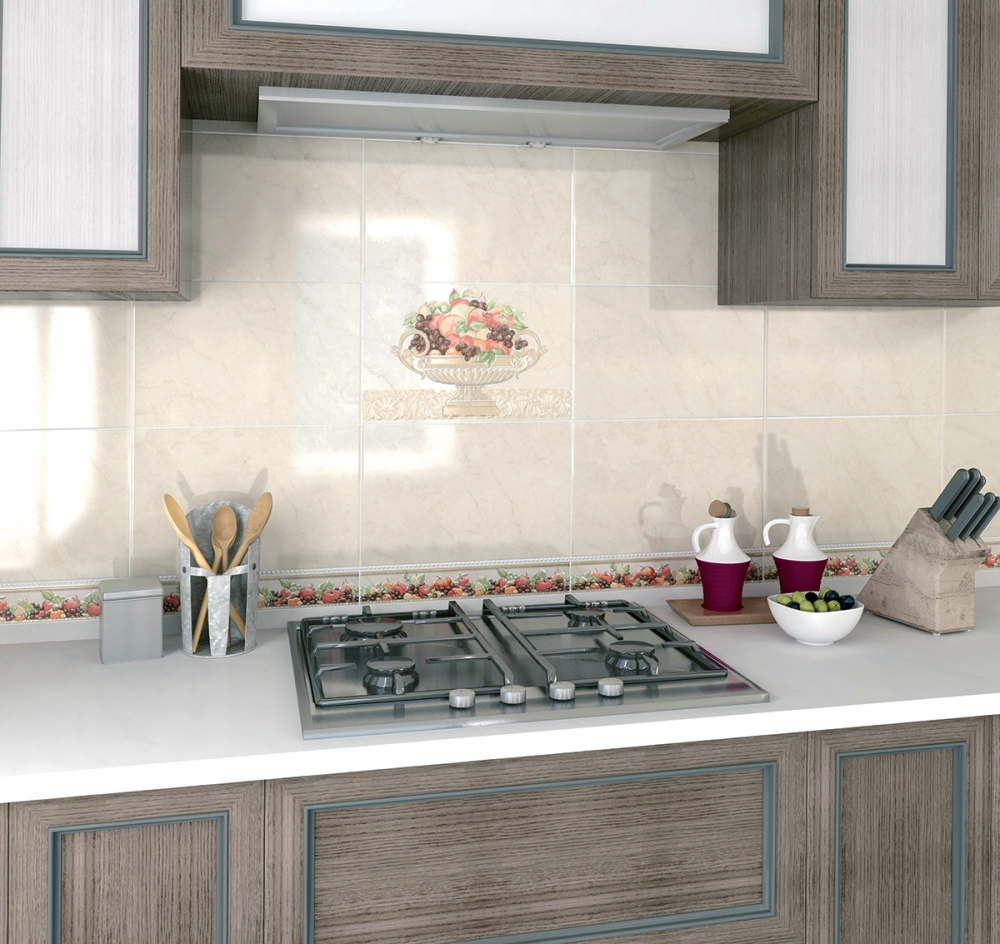
White apron in the interior of the kitchen

Apron in kitchen design
Tip.It is worth experimenting with the addition of cladding as single glass inserts. For example, as a basis for a sealed local illumination of the cooking area with diode bulbs, as in the photo.
Decorative plastic panels are often used along with traditional tiles. They are often offered in a laminated form, imitating various natural textures. Available material is easy to fit, but has a number of significant drawbacks. The polymers show scratches that occur during mechanical cleaning, which are difficult to mask. It is worth clarifying that for lovers often change the decor of tiles in the kitchen, lining an apron with a new design, this is a good budget option, especially in modern style.
Attention. You should be careful with plastic - they should not be lined with surfaces near an open flame due to possible ignition and release of toxic substances during reflow. But closed electric stoves and microwave ovens safely coexist with polymer tiles.

Apron with a pattern in the interior of the kitchen

Apron in the interior of the kitchen
Finishing an apron from metal is less common, but this is a favorite technique of interior designers working in the style of hi-tech and techno. Polished metal tiles go well with chrome fittings and modern fixtures, but it is not suitable for classic styling. Outwardly, this brings a certain coolness to the design, but when in contact with warm objects, the metal lining quickly heats up. As an option - decor made of polymers or painting with imitation of metal.
Natural wood on an apron is very beautiful, but it is extremely undesirable, due to swelling from the water from the sink and the likelihood of ignition by an open flame of the stove. It is replaced with granite or other imitation of the natural texture of wood.
Tip. If a country house with wood trim is infrequently prepared, and the surface of this section of the kitchen wall does not come in contact with water and fire, it is recommended that a moisture-resistant laminate, MDF tile or laminated plywood be replaced. But at the same time fire impregnation is not excluded.
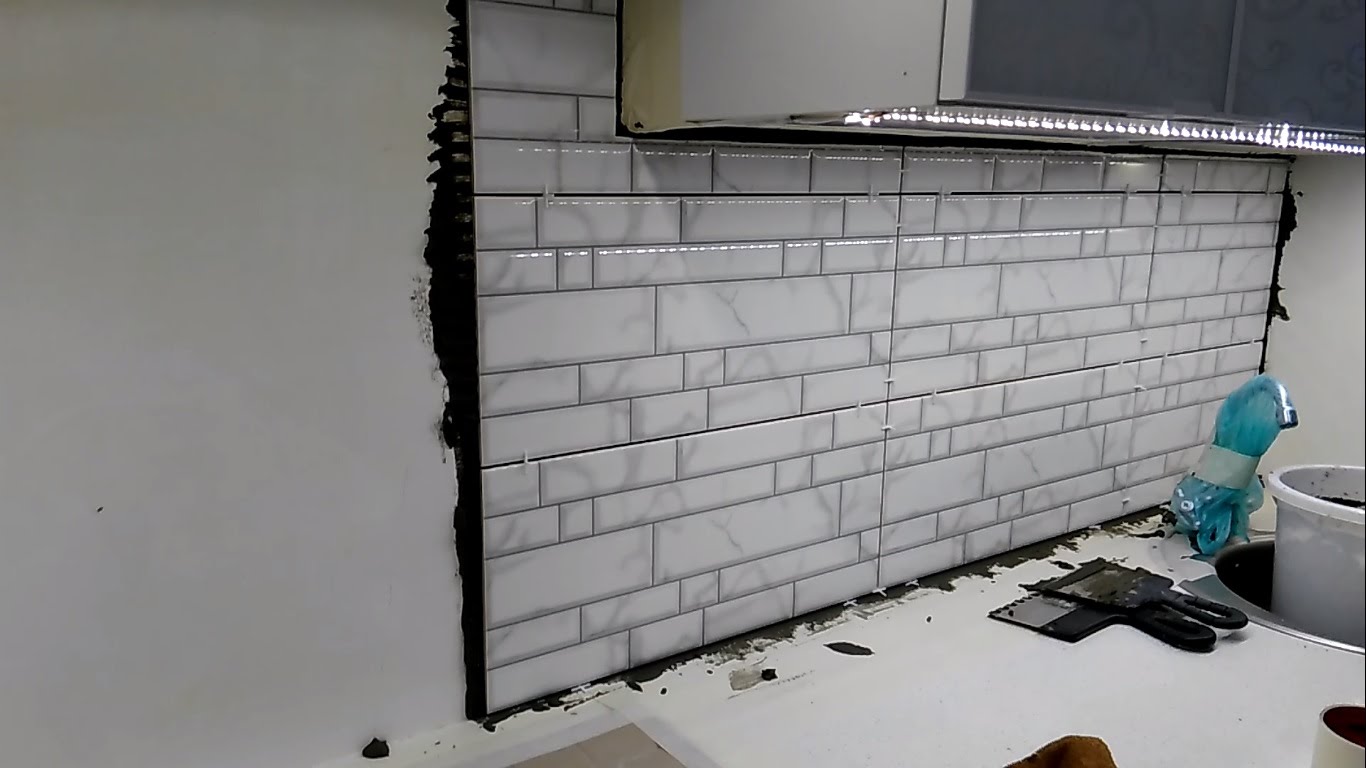
Installation of an apron in the kitchen
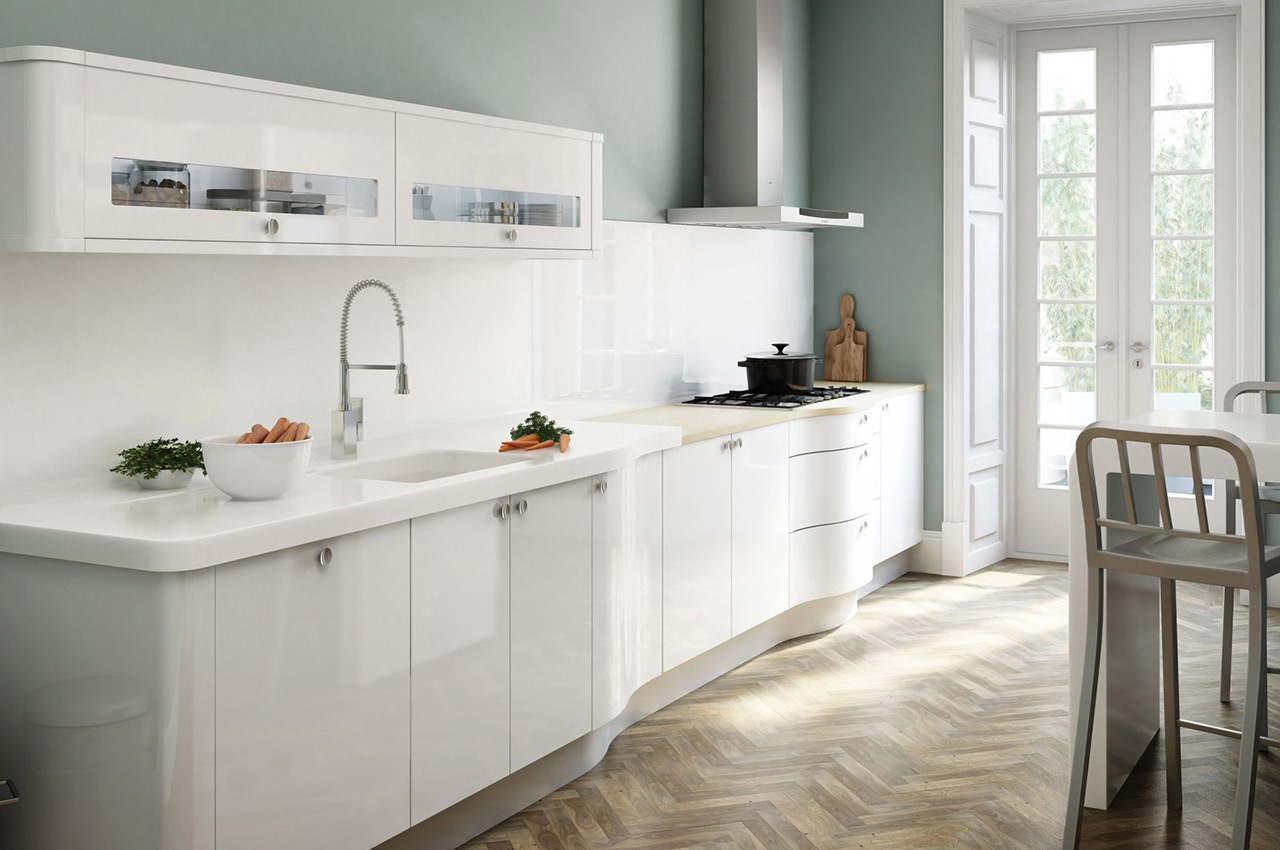
White apron in the interior of the kitchen
Brickwork is a traditional method of decorating a kitchen apron in the loft style and some other areas of interior design. It is better to use real refractory bricks or clinker tiles. One drawback is the difficulty of cleansing the fat suspension, but it is almost invisible.
Attention. The easiest way to clean the brick surface during cleaning is steam. Next, remove the plaque with a spatula and finish with a stiff brush with soapy water, then wipe it with a damp rag and allow to dry. Such a general cleaning is sufficient once every 4-5 months.
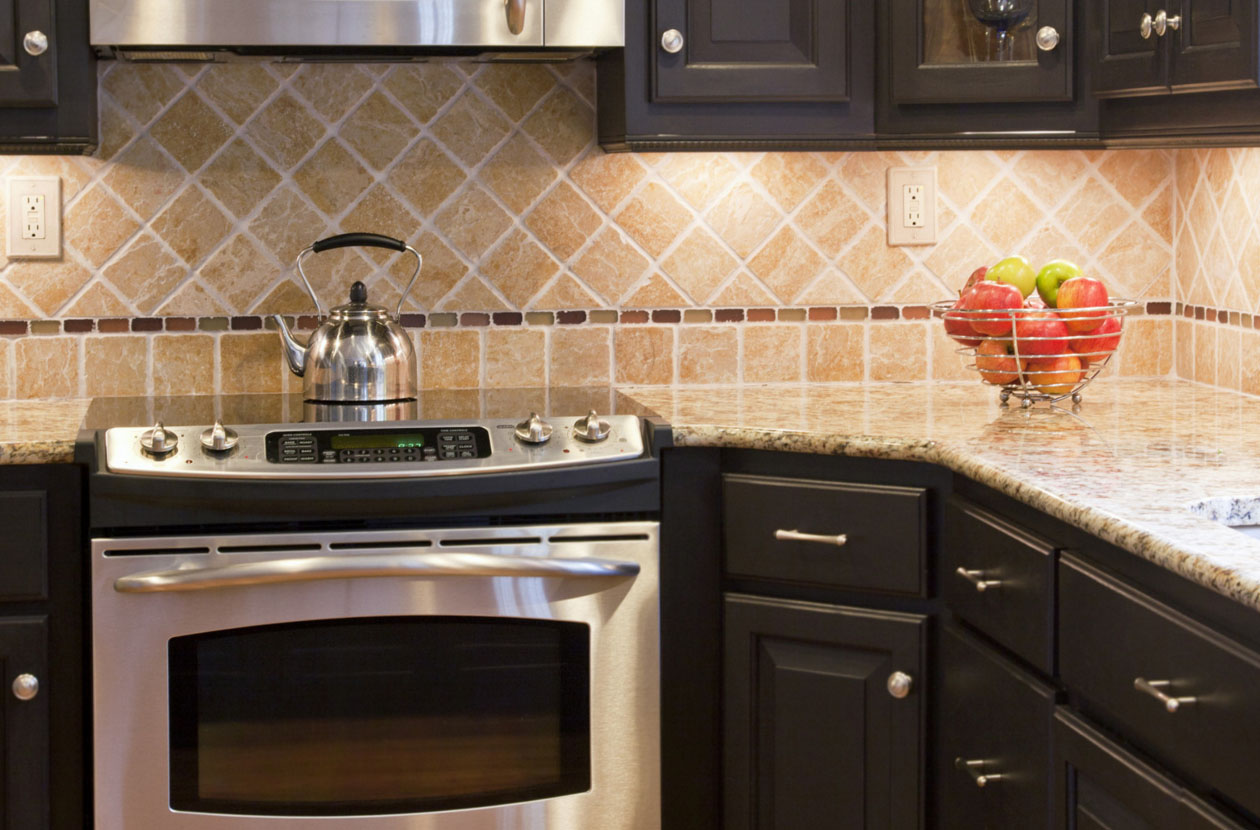
Bright apron in the interior of the kitchen

Green apron in the kitchen with a pattern

Apron with a pattern in the interior of the kitchen
The best opportunity to show your creative inclinations is to make a mosaic panel in the apron area with your own hands. To do this, you need broken tiles, colored glass and mirrors. It is better to take ready-made samples or work according to your own sketch. A master class will help to master the technique.
Before stopping on one of the options, it is worth weighing the pros and cons, taking into account the style of the kitchen and the general concept of decoration.
For inspiration, we offer to look in our gallery the best examples of the new trends of 2017 and classic samples of tiled decor.
Video: Kitchen interior design. Choosing a kitchen apron and facade handles

